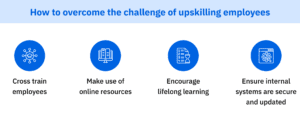The challenge of upskilling employees
In this article, we address the challenge of upskilling employees. It covers strategies, importance, and obstacles in enhancing workforce skills effectively.

According to LinkedIn’s “2023 Workplace Learning Report,” investing in employee training is a top priority in many organizations. The market for global corporate learning and development (L&D) is $350 billion and increasing. Despite this massive industry-wide investment, however, 75% of senior managers at organizations are dissatisfied with their L&D initiatives. So why aren’t these investments yielding the desired results? How can companies overcome the challenge of upskilling employees in the face of a potential 85-million-person talent shortage? Let’s dive in!
What is reskilling and upskilling?Copied
Reskilling and upskilling are often used interchangeably, but there are differences between the two concepts.
Upskilling refers to acquiring higher-level skills to enhance existing abilities, such as taking a programming course to strengthen coding abilities.
Reskilling, meanwhile, is the practice of shifting from one field to another by gaining new skills, such as a construction worker training to become an electrician. These initiatives are increasingly common among those hoping to stay relevant in the modern job market and keep up with ever-evolving technology.
Regardless of which path employees take, understanding how reskilling and upskilling can benefit their futures will prepare them for better job opportunities and career changes.
How do upskilling and reskilling redefine the future?Copied
Upskilling and reskilling have the potential to revolutionize the future of work, and redefine how workers do their jobs. With employees investing time, energy, and resources in acquiring new skills, companies can unlock higher performance, greater efficiency, increased business agility, and scalability.
Fixed roles will no longer bind employees or employers; they can instead leverage technology to bridge career gaps, enabling individuals to develop new talents and confidently pursue ambitious projects.
Upskilling and reskilling also enable people to exponentially increase their value in the labor market, helping them achieve greater job security while realizing their full potential. In short, upskilling and reskilling represent a pivotal shift toward reading individuals and organizations for the future.
Why are reskilling and upskilling important?Copied

Companies that invest in their employees’ professional development often reap the rewards. Reskilling and upskilling a workforce are essential to staying ahead in a competitive market. Here are six reasons why reskilling and upskilling employees is vital for companies.
1. Increased productivity
When employees have access to new skills, they can use them to work more efficiently, leading to increased productivity.
With proper training, employees can develop new methods or processes that increase efficiency and reduce costs. This helps create a culture of growth within an organization, improves customer service, and potentially leads to higher profits.
2. Improved employee morale
Investing in employee education shows that employers value their contributions and want them to succeed professionally.
It also demonstrates that employers are willing to invest in employees’ futures with the company, increasing morale and loyalty.
3. Reduced training costs
Investing in employee reskilling and upskilling can help reduce training costs for businesses by reducing employee turnover rates.
4. Attracting top talent
Offering educational opportunities is an excellent way for companies to attract top talent who may be looking for challenging jobs that provide room for growth and advancement.
5. Closing skills gaps
Because technology evolves exponentially, there will always be a need for new skillsets that may not currently exist in any given organization.
By upskilling and reskilling employees, businesses can ensure that everyone has access to the knowledge necessary for success. This will ultimately lead to more cohesive teams with fewer gaps between positions and departments.
6. Improved team skills
Teams are only as strong as the individual within them. Firms can accomplish both reskilling and upskilling by mapping out adjacent skills – those teams can easily acquire and use alongside existing ones to create a more robust knowledge base and experience set.
Four challenges of upskilling employeesCopied
To remain competitive, companies must invest in upskilling their employees. However, this is not always a simple task. Here are four challenges that companies face when upskilling employees.
1. Hiring and retaining talent.
Nearly three-quarters of employees feel they aren’t reaching their full potential at work. This means it’s more important than ever for companies to create development opportunities within their organizations. This can be challenging when attracting and retaining top talent, as 93% majority of employees desire training that is simple to finish, with 91% wanting that training to be tailored and applicable to their jobs. This means organizations may have to invest time and money in finding the development opportunities best suited to their employees.
2. Staying relevant.
As technology and processes change, employees must stay up to date with the latest skills and knowledge. This can be a challenge for companies, as doing so requires continual employee training and development investment.
3. Building and maintaining company culture.
A strong company culture is essential for attracting and retaining talent, and fostering employee engagement and collaboration. However, maintaining a positive company culture can be challenging, especially as businesses grow and expand into new markets.
4. Reducing internal compliance and threats to data security.
With the average costs of a data breach reaching $4.35 million per incident, businesses must prioritize security. This can be difficult to balance with employees’ need for access to data and company resources.
How to overcome the challenge of upskilling employeesCopied

It’s more important than ever for employees to be upskilled. With technology changing at such a rapid pace, however, it can be challenging to keep up. Here are a few tips on how employers can overcome the challenge of upskilling employees.
Cross train employees
This means training them in different areas to be well-rounded and able to take on different tasks. This will make individual employees more valuable, while improving overall organizational resiliency.
Make use of online resources
Online resources can help employees learn new skills. Companies can better leverage these resources by creating a library of helpful links that employees can easily access.
Encourage lifelong learning
Encourage employees to never stop learning by offering incentives for taking courses or attending conferences. Employers can also host regular in-house training sessions that will help employees stay current on the latest developments in their areas of expertise.
Ensure internal systems are secure and updated
This is vital to retaining top talent. There are many ways to reduce compliance risks, such as regular security audits or employee education on the best practices for data security.
What are some examples of upskilling employees?Copied
One of the most common upskilling examples is supplemental job training. This can be offered by organizations that want to provide their employees with the necessary knowledge to take on more significant, specialized roles.
Some companies are also encouraging employees to obtain certifications or degrees in fields directly or indirectly related to their particular industries. This enables employees to learn new skills and become even more valuable to the business.
Finally, some employers provide online courses that enable employees to learn about topics such as marketing, finance, or coding. A company can reap remarkable rewards by investing time and resources into upskilling its workforce.
Automating skills managementCopied
Automating skills management is the best way to stay abreast of the latest industry trends and ensure compliance with regulating agencies. With AG5, businesses can quickly and easily assess the skills of the workforce, identify gaps, and tailor upskilling opportunities to employees’ needs.
Our software makes tracking employee training and development easy, ensuring that teams are always up to date and compliant with best practices and regulations. Get in touch with us today to learn more about how we can help.

